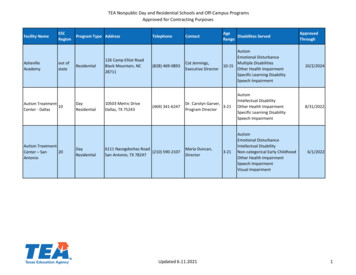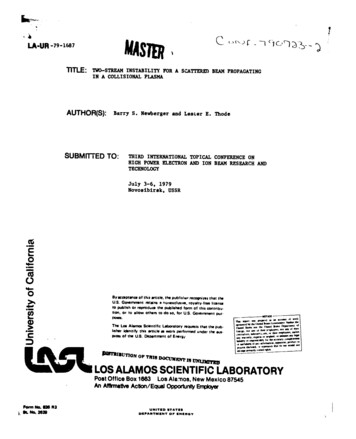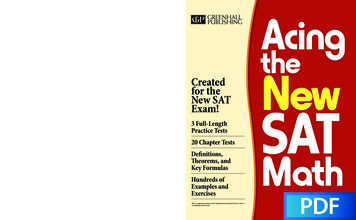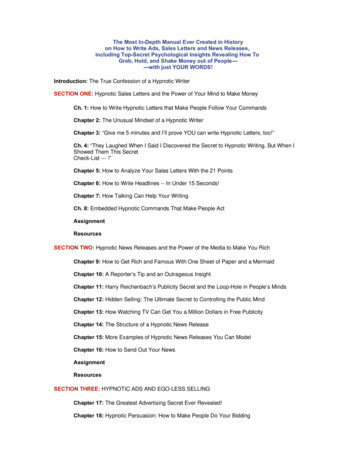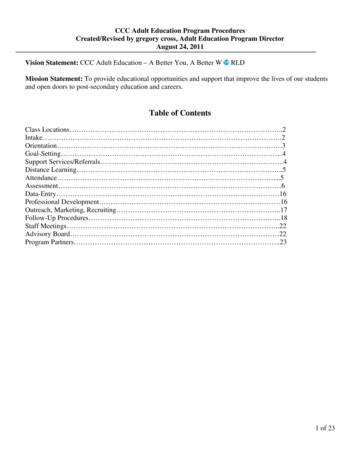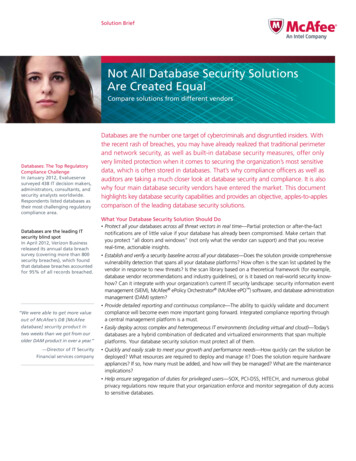
Transcription
Dear Readers,Apart from Software Testing, Social Science is another subject thatattracts me most.Looking at the bizarre events that are happening from last fewmonths in India and also in other parts of the world, it‘s quiteevident that what matters at the end of the day is proper governanceand better management. In my opinion, there should be a strong willof a person to change what is wrong, unethical and what isdangerous in long run.You won‘t be surprised if I connect this with our daily life as aSoftware Testing professional. When we talk about success or failureof any delivery, it does not solely depend on what programmer codesor what we testers test. Its major part lies in its good/bad planning,management and execution. In short, in its overall governance,doesn‘t it?Created and Published by:Tea-time with Testers.Hiranandani, Powai,Mumbai -400076Maharashtra, India.Editorial and Advertising Enquiries:Email: teatimewithtesters@gmail.comPratik: ( 91) 9819013139Lalit: ( 91) 9960556841 Copyright 2011. Tea-time with Testers.This ezine is edited, designed and publishedby Tea-time with Testers.No part of this magazine may bereproduced, transmitted, distributed orcopied without prior written permission oforiginal authors of respective articles.Why I am saying all this is because; it‘s just not enough to be askilled tester. If you have the right attitude along with adequatetesting skills, then there is nothing that can stop you from deliveringyour best. Good tester is not the one who just tests better. Goodtester is one who also asks for what is right, helps others tounderstand what is right and struggles hard to eliminate the wrong.Good news is, we do have such people who are good testers in allaspects and have also contributed in this issue. Along with beinggood testers, they are good Directors, Managers and Leads as well.In this issue of Tea-time with Testers, we have tried our best tocover this aspect of a tester and I am sure you‘ll like all articles.Special thanks to Curtis, T Ashok, Neha and Rikard for theircontribution and highlighting those areas which we always wanted totalk about. Big thanks to Jerry Weinberg for mentoring our readerswith his rich knowledge and experience.Enjoy Reading! Have a nice Tea-time!Yours Sincerely,Lalitkumar BhamareOpinions expressed in this ezine do notnecessarily reflect those of editors ofTea-time with Testers ezine.www.teatimewithtesters.comAugust 2011 2
topIndex P Quicklookfinal indexINDEXA Story of an Independent Testing Team! -14Addicted to Pass / Fail ?- 17Why do We Need to Manage Our Bugs ?-22Mobile Testing: Using Nokia Energy Profiler – 28Testing Intelligence: Improving your Testing using“User Profiles” - 33How Many Hairs do You have on Your Head ?– 37www.teatimewithtesters.comAugust 2011 3
Image: www.bigfoto.comCAST 2011 has shippedOne of the well-known Software Testing Conferences, CAST 2011 concluded successfully on 10th ofAugust this year. Publishing its experience report, written by Jon Bach who was also the chairperson ofthis conference:By Jon Bachon August 12, 2011.“A few minor bugs, but it looks like the value far outweighed theproblems.James and I wanted it to be THE context-driven event, and it was —speakers from around the world, a tester-themed movie, tester games, acompetition, lightning talks, emerging topics, half-day and full-daytutorials, an EdSig with Cem Kaner present on Skype, a live(3D) Weekend Testers Americas session, professional webcasts to theworld, debates, panels, open season, facilitation, music, a real-timeSkype coaching demo, real-time tweets, LIVE blogs posted as ithappened (via http://typewith.me ) and red cards for those who neededto speak NOW.”Read entire report on Jon‘s blog: Click Here!www.teatimewithtesters.comAugust 2011 4
uTest Doubles Down On Security Features, Partners With Veracodeby Mike Butcheron August 14, 2011.In the wake of news recently that software and computers arebeing compromised by hackers and rogue states left right and centre(not to mention the recent attacks on Citibank and Sony) it‘s clearlygoing to make sense that your systems are well checked out, whetheryou‘re a large corporate or a startup.So it‘s timely that software testing marketplace uTest is todayexpanding to offer security and localization testing services. That meansit will have an end-to-end suite of testing services for web, desktop ormobile apps, adding to its existing services like functional, usability andload testing. uTest CEO, Doron Reuveni says the startup is aiming tobecome a ‗one stop shop‘ for real-world testing. READ MORE .For more updates on Software Testing, visit Quality Testing - Latest Software Testing News!www.teatimewithtesters.comAugust 2011 5
www.teatimewithtesters.comAugust 2011 6
Observing and Reasoning About Errors(Part 1)Men are not moved by things, but by the views which they take of them.- EpictetusOne of my editors complained that the first sections of this articleseries spend "an inordinate amount of time on semantics, relative tothe thorny issues of software failures and their detection."What I wanted to say is that "semantics" are one of the roots of "thethorny issues of software failures and their detection."Therefore, I need to start this part of the series by clearing up someof the most subversive ideas and definitions about failure.If you already have a perfect understanding of software failure, thenskim quickly, and please forgive me.www.teatimewithtesters.comAugust 2011 7
1.1 Conceptual Errors About Errors1.1.1. Errors are not a moral issue"What do you do with a person who is 900 pounds overweight that approaches the problem without evenwondering how a person gets to be 900 pounds overweight?" - Tom DeMarcoThis is the question Tom DeMarco asked when he read an early version of the upcoming chapters. Hewas exasperated about clients who were having trouble managing more than 10,000 error reports perproduct. So was I.Over thirty years ago, in my first book on computer programming, Herb Leeds and I emphasized whatwe then considered the first principle of programming:The best way to deal with errors is not to make them in the first place.In those days, like many hotshot programmers, I meant "best" in a moral sense:(1)Those of us who don't make errors are better than those of you who do.I still consider this the first principle of programming, but somehow I no longer apply any moral sense tothe principle, but only an economic sense:(2)Most errors cost more to handle than they cost to prevent.This, I believe, is part of what Crosby means when he says "quality is free." But even if it were a moralquestion, in sense (1), I don't think that Pattern 3 cultures—which do a great deal to prevent errors—canclaim any moral superiority over Pattern 1 and Pattern 2 cultures—which do not. You cannot say thatsomeone is morally inferior because they don't do something they cannot do, and Pattern 1 and Pattern2 software cultures, where most programmers reside, are culturally incapable of preventing largenumbers of errors. Why? Let me put Tom's question another way:"What do you do with a person who is rich, admired by thousands, overloaded with exciting work, 900pounds overweight, and has 'no problem' except for occasional work lost because of back problems?"Tom's question presumes that the thousand pound person perceives a weight problem, but what if theyperceive a back problem. My Pattern 1 and 2 clients with tens of thousands of errors in their software donot perceive they have a serious problem with errors. They are making money, and they are winning thepraise of their customers. On two products out of three, the complaints are generally at a tolerable level.With their rate of profit, who cares if a third of their projects have to be written off as a total loss?If I attempt to discuss these mountains of errors with Pattern 1 and 2 clients, they reply, "Inprogramming, errors are inevitable, but we've got them more or less under control. Don't worry abouterrors. We want you to help us get things out on schedule." They see no more connection betweenenormous error rates and two-year schedule slippages than the obese person sees between 900 poundsof body fat and pains in the back. Can I accuse them of having the wrong moral attitude about errors? Imight just as well accuse a blind person of having the wrong moral attitude about the rainbow.But it is a moral question for me, their consultant. If my thousand-pound client is happy, it's not mybusiness to tell him how to lose weight. If he comes to me with back problems, I can show him througha diagram of effects how weight affects his back. Then it's up to him to decide how much pain is worthhow many chocolate cakes.www.teatimewithtesters.comAugust 2011 8
1.1.2. Quality is not the same thing as absence of errorsErrors in software used to be a moral issue for me, and still are for many writers. Perhaps that's whythese writers have asserted that "quality is the absence of errors." It must be a moral issue for them,because otherwise it would be a grave error in reasoning. Here's how their reasoning might have gonewrong. Perhaps they observed that when their work is interrupted by numerous software errors, theycan't appreciate any other good software qualities. From this observation, they can conclude that manyerrors will make software worthless—i.e., zero quality.But here's the fallacy: Though copious errors guarantee worthlessness, but zero errors guaranteesnothing at all about the value of software.Let's take one example. Would you offer me 100 for a zero defect program to compute the horoscopeof Philip Amberly Warblemaxon, who died in 1927 after a 37-year career as a filing clerk in a hat factoryin Akron? I doubt it, because to have value, software must be more than perfect. It must be useful tosomeone.Still, I would never deny the importance of errors. First of all, if I did, Pattern 1 and Pattern 2organizations would stop reading this book. To them, chasing errors is as natural as chasing sheep is toa German Shepherd Dog. And, as we've seen, when they see the rather different life of a Pattern 3organization, they simply don't believe it.Second of all, I do know that when errors run away from us, we have lost quality. Perhaps ourcustomers will tolerate 10,000 errors, but, as Tom DeMarco asked me, will they tolerate10,000,000,000,000,000,000,000,000,000? In this sense, errors are a matter of quality. Therefore, wemust train people to make fewer errors, while at the same time managing the errors they do make, tokeep them from running away.1.1.3. The terminology of errorI've sometimes found it hard to talk about the dynamics of error in software because there are manydifferent ways of talking about errors themselves. One of the best ways for a consultant to assess thesoftware engineering maturity of an organization is by the language they use, particularly the languagethey use to discuss error. To take an obvious example, those who call everything "bugs" are a long wayfrom taking responsibility for controlling their own process. Until they start using precise and accuratelanguage, there's little sense in teaching such people about basic dynamics.Faults and failures. First of all, it pays to distinguish between failures (the symptoms) and faults (thediseases). Musa gives these definitions:A failure "is the departure of the external results of program operation from requirements."A fault "is the defect in the program that, when executed under particular conditions, causes a failure."For example: An accounting program had an incorrect instruction (fault) in the formatting routine thatinserts commas in large numbers such as " 4,500,000". Any time a user prints a number greater thansix digits, a comma may be missing (a failure). Many failures resulted from this one fault.www.teatimewithtesters.comAugust 2011 9
How many failures result from a single fault? That depends on the location of the fault how long the fault remains before it is removed how many people are using the software.The comma-insertion fault led to millions of failures because it was in a frequently used piece of code, insoftware that has thousands of users, and it remained unresolved for more than a year.When studying error reports in various clients, I often find that they mix failures and faults in the samestatistics, because they don't understand the distinction. If these two different measures are mixed intoone, it will be difficult to understand their own experiences. For instance, because a single fault can leadto many failures, it would be impossible to compare failures between two organizations that aren'tcareful in making this "semantic" ganizationOrganizationOrganizationright.A has 100,000 customers who use their software product for an average of 3 hours a day.B has a single customer who uses one software system once a month.A produces 1 fault per thousand lines of code, and receives over 100 complaints a day.B produces 100 faults per thousand lines of code, but receives only one complaint a month.A claims they are better software developers than Organization B.B claims they are better software developers than Organization A. Perhaps they're bothThe System Trouble Incident (STI). Because of the important distinction between faults and failures,I encourage my clients to keep at least two different statistics. The first of these is a data base of"system trouble incidents," or STIs. In this book, I'll mean an STI to be an "incident report of one failureas experienced by a customer or simulated customer (such as a tester)." I know of no industry standardnomenclature for these reports—except that they invariably take the form of TLAs (Three LetterAcronyms). The TLAs I have encountered include: STR, for "software trouble report"SIR, for "software incident report," or "system incident report"SPR, for "software problem report," or "software problem record"MDR, for "malfunction detection report"CPI, for "customer problem incident"SEC, for "significant error case,"SIR, for "software issue report"DBR, for "detailed bug report," or "detailed bug record"SFD, for "system failure description"STD, for "software trouble description," or "software trouble detail"I generally try to follow my client's naming conventions, but try hard to find out exactly what is meant. Iencourage them to use unique, descriptive names. It tells me a lot about a software organization whenthey use more than one TLA for the same item. Workers in that organization are confused, just as myreaders would be confused if I kept switching among ten TLAs for STIs.The reasons I prefer STI to some of the above are as follows:1. It makes no prejudgment about the fault that led to the failure. For instance, it might have been amisreading of the manual, or a mistyping that wasn't noticed. Calling it a bug, an error, a failure, or aproblem, tends to mislead.www.teatimewithtesters.comAugust 2011 10
2. Calling it a "trouble incident" implies that once upon a time, somebody, somewhere, was sufficientlytroubled by something that they happened to bother making a report. Since our definition of quality is"value to some person," someone being troubled implies that it's worth something to look at the STI.3. The words "software" and "code" also contain a presumption of guilt, which may unnecessarily restrictlocation and correction activities. We might correct an STI with a code fix, but we might also change amanual, upgrade a training program, change our ads or our sales pitch, furnish a help message,change the design, or let it stand unchanged. The word "system" says to me that any part of theoverall system may contain the fault, and any part (or parts) may receive the corrective activity.4. The word "customer" excludes troubled people who don't happen to be customers, such asprogrammers, analysts, salespeople, managers, hardware engineers, or testers. We should be sohappy to receive reports of troublesome incidents before they get to customers that we wouldn't wantto discourage anybody. Similar principles of semantic precision might guide your own design of TLAs,to remove one more source of error, or one more impediment to their removal. Pattern 3 organizationsalways use TLAs more precisely than do Pattern 1 and 2 organizations.System Fault Analysis(SFA). The second statistic is a database of information on faults, which I call SFA,for System Fault Analysis. Few of my clients initially keep such a database separate from their STIs, so Ihaven't found such a diversity of TLAs. Ed Ely tells me, however, that he has seen the name RCA, for"Root Cause Analysis." Since RCA would never do, the name SFA is a helpful alternative because:1. It clearly speaks about faults, not failures. This is an important distinction. No SFA is created until afault has been identified. When a SFA is created, it is tied back to as many STIs as possible. The timelag between the earliest STI and the SFA that clears it up can be an important dynamic measure.2. It clearly speaks about the system, so the database can contain fault reports for faults found anywherein the system.3. The word "analysis" correctly implies that data is the result of careful thought, and is not to becompleted unless and until someone is quite sure of their reasoning. "Fault" does not imply blame. Onedeficiency with the semantics of the term "fault" is the possible implication of blame, as opposed toinformation. In an SFA, we must be careful to distinguish two places associated with a fault, either ofthese implies anything about whose "fault" it was:a. origin: at what stage in our process the fault originatedb. correction: what part(s) of the system will be changed to remedy the fault Pattern 1 and 2organizations tend to equate these two notions, but the motto, "you broke it, you fix it," often leads toan unproductive "blame game." "Correction" tells us where it was wisest, under the circumstances, tomake the changes, regardless of what put the fault there in the first place. For example, we mightdecide to change the documentation—not because the documentation was bad, but because the designis so poor it needs more documenting and the code is so tangled we don't dare try to fix it there.If Pattern 3 organizations are not heavily into blaming, why would they want to record "origin" of afault? To these organizations, "Origin" merely suggests where action might be taken to prevent a similarfault in the future, not which employee is to be taken out and crucified. Analyzing origins, however,requires skill and experience to determine the earliest possible prevention moment in our process. Forinstance, an error in the code might have been prevented if the requirements document were moreclearly written. In that case, we should say that the "origin" was in the requirements stage.to be continued in Next Issue .www.teatimewithtesters.comAugust 2011 11
BiographyGerald Marvin (Jerry) Weinberg is an American computer scientist, author and teacher of the psychology andanthropology of computer software development.For more than 50 years, he has worked on transforming software organizations.He is author or co-author of many articles and books, including The Psychologyof Computer Programming. His books cover all phases of the software lifecycle. They include Exploring Requirements, Rethinking Systems Analysis andDesign, The Handbook of Walkthroughs, Design.In 1993 he was the Winner of The J.-D. Warnier Prize for Excellence in InformationSciences, the 2000 Winner of The Stevens Award for Contributions to SoftwareEngineering, and the 2010 Software Test Professionals first annual Luminary Award.To know more about Gerald and his work, please visit his Official Website here .Gerald can be reached at hardpretzel@earthlink.net or on twitter @JerryWeinbergWhy Software gets in Trouble is Jerry‘sworld famous book.Many books have described How Software IsBuilt. Indeed, that's the first title in Jerry‘sQuality Software Series. But why do weneed an entire book to explain Why SoftwareGets In Trouble? Why not just say people makemistakes? Why not? Because there are reasonspeople make mistakes, and make themrepeatedly, and fail to discover and correctthem. That's what this book is about.TTWT Rating:Its sample can be read online here.To know more about Jerry‘s writing on softwareplease click here .www.teatimewithtesters.comAugust 2011 12
Speaking Tester’s Mindwww.teatimewithtesters.comAugust 2011 13
Neha ThakurBefore I start with this story, I would like to take help of two quotations below - one famous and one notso famous, which explain the importance of the independent testing team in today‘s era and at the sametime, the responsibilities which come with this independence. “Fundamentally you can’t do your own testing; it’s a question of seeing your own blind spots.” Ron Avitzur “With great power comes great responsibility” SpidermanWell, I am a crash-o-holic, in fact that is how I define myself and believe me I am really good at that .I bet there will be very few developers (close to none) in the world who can crash or break their owncreated software/s. This in itself implies the importance of an independent test culture in anyorganization.I have an interesting and a true story to share with you but with following disclaimer:All characters mentioned in this article are NOT at all fictitious(though names changed).Any resemblance to real persons, living or dead is nothing butmere fact.www.teatimewithtesters.comAugust 2011 14
Somewhere in TBD organization, Harry was working as a Quality lead, and was initially assigned towork with a project manager. All the testers were reporting the issues/defects/bugs directly to him. Itwas PM‘s choice to select a few bugs and make those few defects visible to the client. Harry discussedthis issue with the manager and tried to find out his point of views, but from his past experiences healready knew that what could probably be the reasons behind this,somewhere he was juggling with the thoughts, that, can it be timeconstraint, high project pressure from client surmounting or,simply, just to maintain a good face value for organization withminimum bugs and quality. There were numerous reasonsexplained in that discussion and to Harry‘s surprise one reason thatwas obvious to him later was that testers were subjugated becauseof a still existing ancient philosophy{myth} that developers aresmarter than testers. To ease this volatile situation, there wasanother internal project created and all the defects which wererather not important from PM‘s point of view were moved to thisproject. For some time, attention was given to these issues butwhen client started logging issues, they became the priority, andnow the issues logged by quality team at offshore took a backseatand were never attended.The testing team was an enthusiastic one but when they came to know that there is no action takenupon their findings and at the same time client also was unaware of those issues, they weredisheartened. Then came the inflammable discussion which spurred a sequence of events to befollowed, the topic was ―The need of an independent testing team‖ which won‘t directly fall underauthorization of any PM. But at the same time an important question was asked whether the testingteam is capable and mature enough to make its own decisions.Most importantly the quality leads/managers responsibility is to educate the colleagues and co-workersand seniors the importance of testing and how critical it is for a quality project release. How importantit is to keep the test team morale high. Testing is an ART in itself and testers should be treated withmutual respect and everyone should understand the underlying philosophy is that they don‘t have anyself-motive in logging issues rather it‘s the need of the hour and project quality that matters to them.The more transparent the system is the less complication will be there. To run a smooth and successfulproject you need both dev and test team having a strong mutual understanding and respect for eachother‘s work. And this can only be done by understanding each other‘s work and being a helping handto each other at times, right from studying the requirements together and finding gaps, queryresolutions testers can share their test cases/scenarios with the dev team and at the same time testerscan have an understanding of the technical reasons and how important/critical is the bug and this canenhance the bug reporting and gives Dev a better understanding of issues. Well, this in itself is a longtopic and can be consume the entire topic. Moving on to the remaining Story, this continueshereafter After a long battle, finally the management concluded and the deserving side got justice ! Thenstarted the formation of a highly anticipated ―TESTING RULES‖.theyThe following guideline is an important and necessary course of action in order to have an efficientIndependent Testing team. Again the thumb rule is, ―There is no thumb rule‖ as every organizationhas its own needs and demands. In order to cater the demands, there are certain guidelines, whichneeds to be followed but the same guidelines may not make any sense to a different ugust 2011 15
In my opinion, Independent Testing Team is important because:1. An independent testing team is an unbiased one and it has more credibility in finding crucial bugswhich can be missed by developers and which can cause a major impact on the releases. At thesame time it‘s not an understatement to say that team might miss some defects due to its lack ofknowledge of the domain or product but this can be compensated by educating the team.2. The independent test team is well equipped with the latest infrastructure and any special needs ofthe organization can be met in a very short turnaround time. At the same time you can easily findeconomically viable testing teams/organizations having a good expertise and are proficient inferreting bugs.3. Developers can be more productive and will have a more focused approach in improving theproduct/software as their work load will be lessened by an equally productive team whose intentwill also be towards delivering a high quality product.4. The prerogative of the test team will strictly adhere to achieving client‘s business goals andobjectives and will not be deflected in case of changing schedules or the project managementactivities.5. The relationship between the development and the testing team plays a very crucial role in theeffectiveness of the testing, if not handled and guided properly it can lead to a new ―STARWARS‖. When the tester is filing bugs, they should understand the technical limitations andshould have at least good if not strong technical skills in order to better understand the softwareand at the same time may help developers in finding possible solutions and should providedetailed defects summary and reproduction steps always. While at the same time, developersshould not take the amount of defects logged against their modules personally and shouldmotivate the testers as well.6. The outputs are subjected to the proper analysis and minimal exposure of risks and may in turnbe advantageous and end up giving higher ROI, better customer satisfaction as testing isperformed from end user point of view, less time to market and more process oriented periencedsoftwaretestingprofessional whose written articles andpresentations have received awards inmany internal conferences.she is a regular writer for the QAIInternationalSoftwaretestingconference since 2008 and she has alsospoken at the CAST 2009 conference inColorado.Neha is an engineering honors graduate and is currentlyworking as QA Lead at Diaspark INC, Indore, and haspreviously worked as Business Tech Analyst with DeloitteConsulting and as Software Engineer with PatniComputer Systems Pvt Ltd.Her interests and expertise include test automation, agiletesting and creative problem solving techniques.Neha is an active and enthusiast speaker on any topicrelated to testing and has presented papers on varioustopics at STC in last few years.www.teatimewithtesters.comAugust 2011 16
RikardI just use it; there are no disturbing effects (Anonymous addict)Many years ago, people in software testing thought that complete testing was possible. They believedeverything important could be specified in advance; that the necessary tests could be derived; and thencheck if the outcome was positive or negative.Accelerated by the binary disease this thinking made its way into many parts of the testing theory, andis now adapted unconsciously by most testers.We now know that testing is a sampling activity, and that communicating what is important is thefundamental skill, but what started as a virus, has become an addiction very difficult to get rid of.SymptomsThe most important thing to do after a test, is to set a Pass or a Fail in the test managementsystemYou feel a sense of accomplishment when you set Pass/Fail and move on to the next testYou spend time and energy reporting Pass/Fail, terminology that don‘t mean a lotYou structure your test in un-productive ways, just so Pass/Fail can be usedYou reduce the value of requirements documents by insisting everything must be verifiableYou think testing beyond requirements is very difficultYou count Passes and Fails, but don‘t communicate what is most importantYou don‘t consider Usability when testing, even though you‘d get information almost for freeYou haven‘t heard of serendipityStatus reporting is easy since counting Pass/Fail is the essencewww.teatimewithtesters.comAugust 2011
Tea-time with Testers ezine. Dear Readers, Apart from Software Testing, Social Science is another subject that attracts me most. Looking at the bizarre events that are happening from last few months in India and also in other parts of the world, it‘s quite evident that wh
